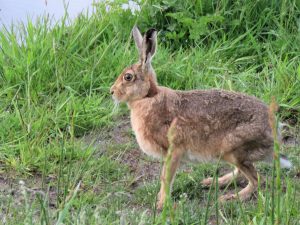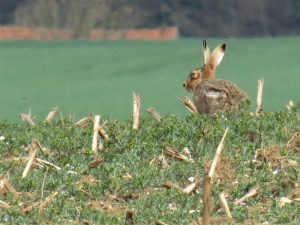Nature Note March 2022
The Brown Hare

As fans of Alice in Wonderland will know, one of the central characters at the Mad Hatter’s Tea Party was the March Hare. S(he) was an ideal companion for the Mad Hatter, as her/his behaviour was eccentric. Most readers would be aware that hares are mad in March. “As mad as a March Hare” is an English expression recorded in literature at least as far back as 1546.
The phrase relates to activity frequently observed in spring, with two or more hares chasing around an open field, sometimes culminating in a ‘boxing’ match. Two hares stand on their back legs and use their front claws and teeth, at times pulling lumps of fur from their ‘opponent’. This is commonly, wrongly, thought to be two males fighting. It is in fact a female (Jill) rejecting unwelcome advances from a male (Jack).
Spotting hares
Fighting or not, March is an excellent month to see brown hares. They live above ground, unlike rabbits in their warrens, and can be easy to find on large open fields before cereal crops grow high. To avoid predation, they hunker down in a scrape known as a ‘form’ and rely on camouflage, plus the ability to run very quickly, up to 45 mph, from a potential predator. It is sometimes possible to get close to a hare in its form, if you approach slowly and quietly.
Unlike the native mountain hare, found in uplands areas including the Peak District, brown hares are a naturalised, introduced, species. As they can weigh up to 5 kg., their introduction was for both their meat and their warm fur. They have been around since at least Roman times and are protected under Wildlife and Countryside legislation.
Compared with rabbits, they are longer-bodied and significantly heavier. Their legs are longer relative to body size and they have long, black-tipped ears. When seen running they have a forward–tilted appearance whereas rabbits look flat-backed.

Females can have up to four broods of young (leverets) three or four times a year. However, we are not overwhelmed by hares as mortality rates are high amongst the young. Also, adults typically live only two or three years. They are a vegetarian species eating soft vegetable matter and the bark from young trees.
Can you find and photograph some ‘boxing hares’ this month?
David Scott




 Langton Community Hall
Langton Community Hall

